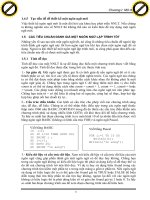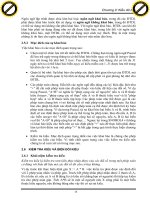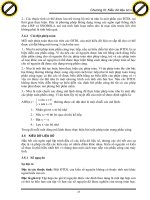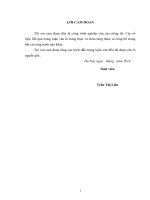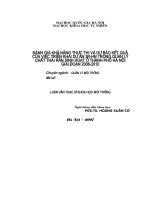triển khai Bim trong kết cấu của dự án
Bạn đang xem bản rút gọn của tài liệu. Xem và tải ngay bản đầy đủ của tài liệu tại đây (2.83 MB, 35 trang )
BIM Essential Guide
For C & S Consultants
BIM Essential Guide – For C&S Consultants
BCA acknowledges the leadership provided by
the BIM Steering Committee in support of the
production of the BIM Essential Guides
The BIM Essential Guides have been drafted by
the Centre for Construction IT on behalf of BCA
and the BIM Steering Committee.
©Building and Construction Authority 2013
Building and Construction Authority
5 Maxwell Road
#16-00 Tower Block MND Complex
Singapore 059110
www.bca.gov.sg
First published August 2013
While every effort has been made to ensure the
accuracy and quality of information contained
in this publication, the Building and
Construction Authority, its employees, agents
or industry partners can take no responsibility
for the subsequent use of this information, nor
for any errors or omissions that it may contain.
Cover image and design courtesy of RSP
Architects Planners & Engineers (Pte) Ltd and
the BCA Academy of the Built Environment.
ii
BIM Essential Guide – For C&S Consultants
Contents
CEO’s Message ___________________________________________________________________ iv
ACKNOWLEDGEMENTS ____________________________________________________________ v
OBJECTIVES _____________________________________________________________________ 1
Suggested BIM Deliverables ________________________________________________________ 2
Concept Design Stage _____________________________________________________________ 3
Understanding ClientRequirements and Design Parameters _____________________________ 3
Schematic Design Stage ____________________________________________________________ 4
Preliminary Structural Model _____________________________________________________ 4
Structural Analysis _______________________________________________________________ 10
Analytical Model for Foundation Design ____________________________________________ 10
Analytical Model for Superstructure & Member Design ________________________________ 11
Detailed Design Stage ____________________________________________________________ 14
Substructure Modelling Guidelines ________________________________________________ 14
Superstructure Modelling Guidelines ______________________________________________ 15
Civil Defence Shelter Modelling Guidelines __________________________________________ 22
Expected Output for ST & CD Submissions __________________________________________ 23
Collaboration with Other Disciplines _________________________________________________ 25
Collaboration with Architects ____________________________________________________ 25
Collaboration with Civil Engineers /Registered Surveyors _______________________________ 26
Collaboration with Mechanical, Electrical & Plumbing (MEP) ____________________________ 26
Collaboration with Contractor/Fabricator/Precaster __________________________________ 28
Collaboration with Quantity Surveyors & Facility Managers _____________________________ 28
Others ________________________________________________________________________ 29
Model version control __________________________________________________________ 29
iii
BIM Essential Guide – For C&S Consultants
CEO’s Message
Dear readers,
Building Information Modelling (BIM) has gained much traction in recent
years as digital construction technology that will fundamentally transform
the building and construction industry practice in the delivery of an
excellent built environment. It is a game changing technology that will
improve the construction productivity as well as the level of
integration and collaboration across the various disciplines in the
construction value chain. It is therefore important for the
industry to embrace the technology with clarity.
The BIM Essential Guides are part of the industry’s efforts to demystify BIM and to give clarity
on the requirement of BIM usage at different stages of a project.
Under the leadership of the BIM Steering Committee chaired by Er Lee Chuan Seng, Emeritus
Chairman, Beca Carter, and comprising of leaders in BIM, the BIM Managers Forum has
contributed much time and effort to compile the various best practices to make this Guide
possible over a short span of time. We would like to thank them for their contribution.
We hope that every BIM user can truly reap the benefits of BIM by integrating it into his/her
day-to-day workflow – from feasibility study to facility management. We hope that BIM users
can use these guides as a platform to jumpstart their BIM adoption, before they leap to
greater heights, innovating and transforming their workflow.
BIM is a journey. We envisage that it will grow with time and will inspire more advanced and
innovative use of BIM. I would like to encourage all BIM practitioners to join in this industry
effort to grow this Guide into a wealth of BIM knowledge.
Dr John Keung
iv
BIM Essential Guide – For C&S Consultants
ACKNOWLEDGEMENTS
BCA would like to acknowledgement the contributions of the following organizations which
had provided their valuable inputs in the development of this guide:
TY Lin Singapore
Carrie Chan
Arup Singapore
RupinderWilkhu
AECOM Singapore
Corinne Lim
P & T Consultants
Ivy Tay
ST Architects & Engineers Pte Ltd
Wan Fook Sing
KTP Consultants
Serene Lim
RSP Architects and Engineers
Ho Sing Yee
BECA Carter &Ferner Singapore
Christina Koh
Ong&Ong Consultants
Anthony Chuaheyia
SH Ng Consultants
AyingaranThevathasan
Centre for Construction IT
Sonny Andalis
Image Credits:
Foundation Elements
TYLin Singapore
Foundation Elements and Typical Connections
RSP Engineers
Hybrid Structural Detailing
LSW Consulting Engineers
Hybrid Structural Detailing
JTC Consultants
Structural BIM Model
AECOM
Structural BIM Model
P&T Consultants
Secondary Structural Elements Model
CityTech Consultants
v
BIM Essential Guide – For C&S Consultants
OBJECTIVES
The objective of this Essential Guide is to assist C&S (Civil & Structural) to develop models in
their BIM project, including New Construction and A&A Projects. It is a graphical guide that
shows the possible use-cases of BIM for various Design Stages of the project.
This is a general document that covers a few typical buildings and not an extensive document
that covers all scenarios that might arise based on specific projects. Users are allowed to
edit/change accordingly to suit their needs.
This Essential Guide is not based on any particular BIM software and does not cover any
explanation or steps on its usage. For help and guide for your specific BIM software, please
refer to your software user manual.
Based on the project requirement, type and time line choose the BIM use and implement in
the project.
1
BIM Essential Guide – For C&S Consultants
Suggested BIM Deliverables
STAGE
SUGGESTED BIM DELIVERABLES (STRUCTURAL ONLY)
1. Preparation &
Conceptual
Design
a.
b.
c.
d.
a.
b.
c.
d.
2. Schematic
Design
3. Detailed Design
4. Construction
e.
a.
b.
c.
d.
e.
a.
b.
c.
d.
5. As Built
6. Facility
Management
e.
a.
b.
a.
Soil profile & foundation options
Material use: concrete, steel, aluminium, etc…
Construction method: in-situ, precast, prefab, etc.
Design code to be used: ACI, BS, EN, etc.
Preliminary Model based on Architectural Massing models
Design Criteria / Brief, Framing Options & Alternate Design
Preliminary structural analytical model
Preliminary Design Coordination Report b/w Architectural &
Structural models
Preliminary cost estimate for Structural models
Final Structural Model to produce ST & CD submission drawings
Final structural analytical model and calculation report
Clash detection & resolution report b/w Architectural, Structural
& MEP
Spatial Validation Report
Detailed cost estimate, BOQ, tender docs prepared by QS
Design Validation Report (depth of piles, temporary structures,
site restrictions, etc.)
RFI Resolution & Constructability Report
Contractor Model to produce Shop & Fabrication Drawings
(rebar & steel)
Single Services Drawings (SSD) & Combined Services Drawings
(CSD)
Detailed schedule of materials & quantities
As constructed drawings from Consultant
Verification checks using laser scanners, survey data, etc…
As built Structural Model from Contractor
Note: Regulatory BIM e-submissions are excluded from the above list because the timing of submission may vary
due to individual project requirements.
2
BIM Essential Guide – For C&S Consultants
Concept Design Stage
UNDERSTANDING CLIENT REQUIREMENTS AND DESIGN PARAMETERS
Both the client and the engineer should reach an understanding on the purpose of BIM to fulfil
Client’s Requirements.
Example of some questions that can be asked to understand the Client’s Requirements.
What are the overall goals in this BIM project?
What are the specific goals that have to be achieved by BIM in this BIM project?
What are the possible ways to achieve the specific BIM goals?
Is the client aware and agreeable that the design team may use a different way to
achieve the specific BIM goals?
Suggested BIM Deliverables:
1) Prepare design criteria and project brief
2) Study soil report and explore foundation options.
The Qualified Person (QP) the Professional Engineer (PE) shall identify what type of
foundation best suit existing soil conditions.
3) Identify material (concrete; steel; timber; aluminium; glass) and grade to be used
4) Identify construction method: in-situ, precast, prefab etc.
5) Identify the code of practice (BS or EN) for structural design
6) Identify the extent of civil/external works but not limited to: road alignment; water
supply; sewer and drainage; existing utilities survey; earthworks like soil excavation or
backfill and electrical and communication supply enclosures
The preliminary Structural BIM Model could be referenced from the Architectural BIM model
and serves as a preparation for the Detailed Design stage. Before starting the actual
modelling, it is recommended to go through proper planning and preparation.
There are no BIM models under this stage.
3
BIM Essential Guide – For C&S Consultants
Schematic Design Stage
PRELIMINARY STRUCTURAL MODEL
The Preliminary Structural Model (PSM) shall be based from the equivalent Architectural BIM
model and serves as a reference for the next evolution of into Detailed Design stage. Before
starting the actual modelling, it is recommended to go through proper planning and
preparation by completing the BIM Execution Plan or BEP.
The PSM is suggested to include the following:
1) Initial sizes of all load bearing elements with indicative dimensions.
Load bearing elements are defined as supporting a load of the structure above
including its own weight shall be modelled. The QP/PE can exclude/ignore all non-load
bearing elements like:
Doors & Windows
Dry Walls
Furniture
Curtain Systems like glass or precast cladding
Roof excluding Trusses
Planter Boxes and Drains
Prefabricated Bathroom Units (PBU)
Bay Windows, Parapets and Ledges
Staircase Railings
MEP Pipes, Ducts, Cable Trays, Fixtures, Terminals and Fittings
Fig. 1: Load Bearing Elements Only
4
BIM Essential Guide – For C&S Consultants
2) Foundation elements like the following but not limited to:
Bored Piles
Spread/Isolated Footing
Retaining & Diaphragm Walls
Continuous Bored Piles (CBP) Walls
Mat Slabs or Raft Foundation
Soil Stabilization like Jet Grouting Columns and Micro Piles
Fig. 2: Foundation Elements (Image courtesy of RSP)
Fig. 3: Continuous Bored Pile (CBP) wall and Mat Foundation (Image courtesy of TYLin)
5
BIM Essential Guide – For C&S Consultants
3) Digital Terrain Model (DTM) showing existing soil conditions and properties; soil
contour and profile.
Fig. 4: Digital Terrain Model (Image courtesy of CCIT)
4) Design Object Library (DOL) of commonly used elements including unique objects like
precast, post-tension and built up steel sections cut from plates.
Fig. 5: Structural Objects-Columns and Trusses (Image courtesy of CCIT)
6
BIM Essential Guide – For C&S Consultants
5) Modelling of primary load bearing elements:
Structural Columns
Structural Girders
Structural Floors (Suspended, Composite and Precast)
Structural Walls
Structural Foundations (Grade Beams, Piles & Pile Caps)
Tunnel Structures greater than 6.0 meters in depth and 1.0 in diameter
Structural Trusses
Crane and Hoisting Structures
Civil Defence (CD) Shelter
Bridge Piers
Fig. 6: Capitaland Bedok Mixed Development Model (Image courtesy of AECOM)
All objects shall be accurately classified into its correct construction material
and category. For example, columns can either be made of reinforced
7
BIM Essential Guide – For C&S Consultants
concrete or steel. Category refers to the classification system employed by the
BIM authoring tool.
Fig. 7: Eco Sanctuary Superstructure Model (Image courtesy of P&T Consultants)
For example, avoid defining a column into a wall category. Downstream
application like quantity take off and time scheduling are dependent on the
defined categories of objects.
6)
Fig.
URA Combined
(Image courtesy of Parsons Brinckerhoff)
Modelling
of8:secondary
loadServices
bearingTunnel
elements:
8
BIM Essential Guide – For C&S Consultants
Structural Joist
Structural Purlin
Structural Bracing
Staircase (Landing Beams; Stringers and Slabs)
Plinth or Equipment Pads
Ramps
Fig. 9: HDB Lift Upgrading Program
Fig. 10: Staircase Elements
(Image courtesy of CityTech Consultants )
(Image courtesy of CCIT)
9
BIM Essential Guide – For C&S Consultants
Structural Analysis
ANALYTICAL MODEL FOR FOUNDATION DESIGN
Structural drawings are graphical representations of design calculations to the agreed code of
practice as per BCA regulations. During the transition stage both the withdrawn British
Standards (BS) and upcoming Euro codes (EN) are accepted.
1. Boundary conditions shall be properly defined in the BIM authoring tool for fixed, pinned
and user defined supports like springs. Supports can be point for columns, line for wall
footings and area for mat foundation and slab on grade.
Fig. 11: Support/Boundary Conditions (Point, Line & Area)
2. Soil springs for piles, earth retaining structures shall be properly modelled based on the
existing soil condition as described in the geotechnical report.
Fig. 12: Soil Spring Supports
10
BIM Essential Guide – For C&S Consultants
ANALYTICAL MODEL FOR SUPERSTRUCTURE & MEMBER DESIGN
BCA encourages QP to synchronize the physical models generated by BIM authoring software
with the structural analytical models created simultaneously used for member design.
1. All beams shall be modelled span to span to satisfy criteria for unsupported length in the
analytical models
Fig. ?: Soil Spring Supports
Fig. 13: Framing Elements span to span (Image courtesy of CSC)
2. All columns shall be modelled by level to satisfy criteria for slenderness ratio in the
analytical models
Fig. 14: Columns by Storey (Image courtesy of CSC & CCIT)
11
BIM Essential Guide – For C&S Consultants
3. Slabs shall be modelled for every panel bounded by beams for proper load transfer.
Consideration shall be taken for difference in elevation like drops and mezzanine floors. If
slabs are modelled as single elements, care shall be exercised when converting to
analytical models to make sure loads are decomposed to tributary magnitudes for
triangular and trapezoidal load distributions.
Fig. 15: Floor Slab Load Distribution (Image courtesy of CCIT)
Fig. 16: Floor Slab Panel by Panel (Image courtesy of CCIT)
12
BIM Essential Guide – For C&S Consultants
4. The analytical model created in parallel with the physical models in a BIM authoring
software must be fully connected before exporting to 3rd party structural analysis engines.
If necessary provide rigid links to connect offset analytical lines to each other.
Fig. 17: Beam analytical lines corrected to reflect unsupported length (Image courtesy of CCIT)
Fig. 18: Tapered wall analytical lines corrected (Image courtesy of CCIT)
13
BIM Essential Guide – For C&S Consultants
Detailed Design Stage
SUBSTRUCTURE MODELLING GUIDELINES
Temporary works or earth retaining and stabilizing structures (ERSS) but not limited to:
1) Diaphragm & Earth Retaining Structures
2) Walers
3) Cofferdams
4) Piling Platform
5) Trenches and Excavations less than 6.0 in depth
6) Temporary slopes and Stockpiles
These structures generally are not required to be modelled unless the structure is intended to
be permanently installed and not be disassembled upon completion of the construction.
Fig. 19: Temporary Structures (Image courtesy of CCIT)
14
BIM Essential Guide – For C&S Consultants
SUPERSTRUCTURE MODELLING GUIDELINES
1. Structural connections can be done in either 3D or 2D details. Connections can be
reinforcing bars for concrete; bolts and welds for steel or steel members.
For rebar connections:
a. Rebar schedules for beam, column, walls and slabs are allowed.
Fig. 20: Structural Beam Schedule (Image courtesy of JTC)
Fig. 21: Structural Slab & Column Schedule (Image courtesy of RSP)
15
BIM Essential Guide – For C&S Consultants
b. Hybrid approach. Element profile generated from BIM objects supplemented with
2D annotations like rebar, dimensions, spacing and curtailment.
Fig. 22: Structural Beam Detail (Image courtesy of LSW)
Fig. 23: Structural Slab Detail (Image courtesy of JTC)
16
BIM Essential Guide – For C&S Consultants
c. 3D rebars is encouraged if featured is available. BIM tools like Tekla Structures,
Graitec Advance Concrete, Bentley ProConcrete are able to generate 3D structural
connections generated from BIM models.
Fig. 24: Structural Beam 3D Rebar (Image courtesy of CCIT)
Fig. 25: Structural Staircase and Column 3D Rebar (Image courtesy of CCIT)
17
BIM Essential Guide – For C&S Consultants
d. Specialty works like precast rebar and post tension tendons can be submitted as 2D
drawings provided by the specialty consultant/contractor.
Fig. 26: Revit Precast & Post-Tension Elements (Image courtesy of CCIT)
Fig. 27: Nemetschek Allplan Precast Elements (Image courtesy of CCIT)
18
BIM Essential Guide – For C&S Consultants
For steel connections:
a. Pre-qualified steel connections in 2D CAD can be used using drafting or detailed
view.
Fig. 28: Structural Steel Connections (Image courtesy of RSP)
b. 3D steel connections. If available, it is recommended to use 3D connections
showing bolt, weld and composite connections. Suggested details include all
openings/penetrations, shear studs, metal deck, and bracing.
Fig. 29: Structural Steel Connections 1 (Image courtesy of CCIT)
19
BIM Essential Guide – For C&S Consultants
Fig. 30: Structural Steel Connections 2 (Image courtesy of CCIT)
Fig. 31: Structural Steel Connections 3 (Image courtesy of CCIT)
20




